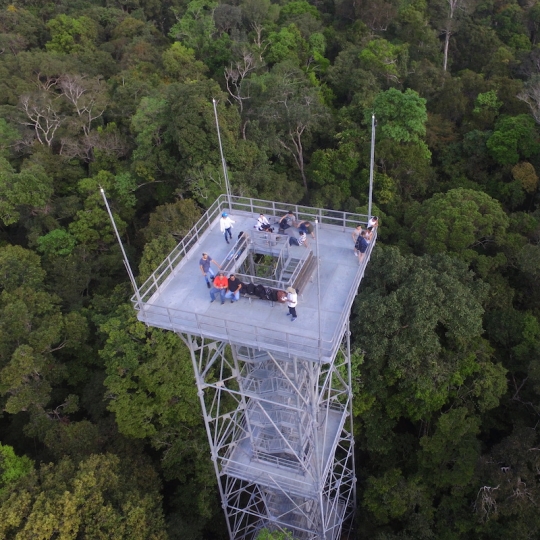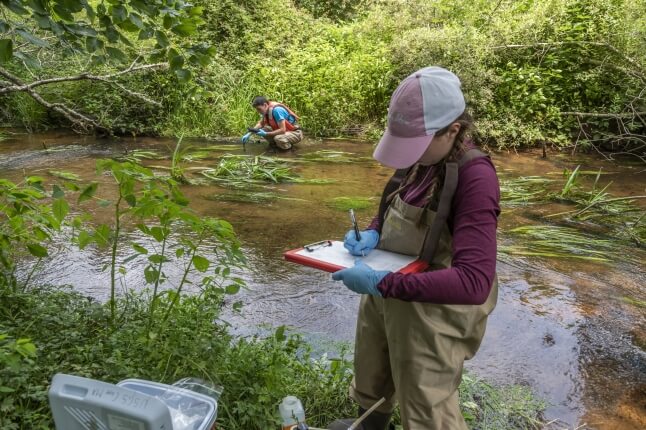News
Drones launch from a tower in the Amazon rainforest to map and monitor the unique chemical signals emitted by trees known as volatile organic compounds (VOCs).
The Amazon basin, home to the largest rainforest in the world, plays a crucial role in maintaining the planet’s carbon budget, absorbing and storing billions of tons of carbon dioxide annually. But a tipping point looms on the horizon — one that may turn one this vital carbon sink into one of the largest sources of carbon dioxide on the planet.
By “smelling the forest,” a Harvard-led team of researchers is attempting to measure how and when that could happen.
As the planet warms, drought, wildfire and changing weather patterns threaten some 400 billion trees in the Amazon, some of which are already at risk from logging and mining. As trees are damaged — or killed — they decompose and release carbon into the atmosphere.
“Climate change, as well as human-caused deforestation and biomass burning, can lead to ecological and climatic tipping points that could release massive pools of stored carbon,” said Scot Martin, the Gordon McKay Professor of Environmental Science and Engineering at the Harvard John A. Paulson School of Engineering and Applied Sciences (SEAS) and Professor of Earth and Planetary Sciences in the Department of Earth and Planetary Sciences.
The question is: how do we know when we’re approaching that tipping point?
Martin, with an international team of researchers and collaborators from Amazonas State University (UEA) and the Amazonas State Research Support Foundation (FAPEAM), has developed an early detection system to monitor changes in the Amazon.
Martin’s research aims to better understand how the Amazon responds to stress. In one on-going project, funded by Harvard University’s Climate Change Solutions Fund (CCSF), Martin and his team are mapping and monitoring the unique chemical signals emitted by trees known as volatile organic compounds (VOCs).
We’ve all sensed VOCs — they’re what you smell in newly mowed grass or walking through a pine forest. Like human pheromones, VOCs help plants interact with organisms around them. They attract insects for pollination and seed dispersal, respond to stresses, and even send warning signs to neighboring plants that predators are attacking. Every species of plant emits a different VOC signature — like a fingerprint — which can change based on the season or if the plant is under duress from, for example, drought or flood.
“Forests can speak to us through VOCs,” said Martin. “Translating these signals can lead to a quantitative understanding of how forest ecosystems respond to climate stress and climate change.”
“Forests can speak to us through VOCs.”
But there are major challenges to collecting data on VOCs. First, the Amazon rainforest covers a staggering 550 million hectares. Within that massive biome are thousands of smaller ecosystems, each with their own biodiversity and VOC signals.
Airplanes can cover large distances but can’t fly low enough to collect VOC samples, which reach heights of about a kilometer or less above the canopy. Towers can sense at the right height but only for the local ecosystem.
To bridge this canyon of data, Martin and his team are turning to drones.
“What makes drone-based sensors so exciting is that they offer the possibility of collecting data at unexplored scales,” said Martin. “This could lead to revolutionary insights into Amazonian ecosystems under climate stress and anticipated changes in climate and biodiversity.”
This summer, the team journeyed deep into the Amazon to test a VOC sampling prototype developed by Daniel Wang S.B. ’17 for his senior design thesis. The prototype, a small sampling box attached directly to a drone, pulls in air from the surrounding environment and passes it through sampling tubes that trap VOC molecules. Under the guidance of advisors Martin and Karena McKinney, Associate in Environmental Science & Engineering, Wang used lightweight materials that could withstand high jungle temperatures and humidity.
The test was a success.
“The instrument operated flawlessly,” said Wang.
The team launched the prototype from a tower located in the Manaus Botanical Garden (MUSA). The team tested the range and limits of the drone, sending it to specific GPS points up to a kilometer away from the tower. The drone collected samples at various altitudes and specific points along the way, and returned home every time.
“The experience of being in the jungle, with a device I designed on a bench back at Harvard, was incredible,” said Wang. “We were able to fly this technology into previously unexplored spaces and collect samples that will hopefully tell us more about the jungle’s chemical fingerprint.”
With funding from the CCSF, Martin and his team of Brazilian collaborators will continue to develop, test and fly VOC sampling drones above the Amazon.
The team is currently flying drones over different types of forests, including low-lying waterlogged regions and higher terra firma forests, to develop a database of VOC fingerprints under normal conditions. After that, the same forests will be monitored during times of stress in the wet and dry season to learn how the VOC fingerprints change.
Martin and the Harvard team visit the Amazon half a dozen times a year.
While Martin is back at Harvard, his Brazilian collaborators —four PhD students at UEA — continue to develop the drones and sampler technology and the VOC analysis techniques.
This collaboration is key to the project’s success.
“I believe in iterative success,” said Martin. “Anyone can become an expert after 100 rounds of feedback. Through the UEA and FAPEAM collaboration with SEAS, the local UEA PhD students can carry out one flight and VOC analysis every 24 to 48 hours. So, within half a year, you have the best team on the planet doing these flights. Without that collaboration, it would take the Harvard team a decade to build that expertise. So, this collaboration is great not just for science relevant to humanity but also to the combined team of students, postdocs, and faculty in the UEA-FAPEAM-SEAS collaboration.”
Topics: Environment
Cutting-edge science delivered direct to your inbox.
Join the Harvard SEAS mailing list.
Scientist Profiles
Scot T. Martin
Gordon McKay Professor of Environmental Science and Engineering and Professor of Earth and Planetary Sciences
Press Contact
Leah Burrows | 617-496-1351 | lburrows@seas.harvard.edu




